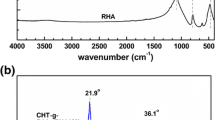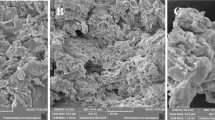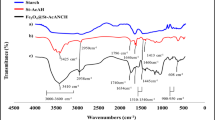Abstract
Superabsorbent hydrogels composites based on the biopolymer starch (ST) and rice husk ash (RHA) were successfully developed and tested towards the removal of methylene blue (MB), a cationic dye. RHA content hit the morphology, mechanical and water uptake properties of the composite. Batch adsorption experiments, carried out under pH 5 at 33 °C and with 2000 mg L−1 as the initial concentration of MB, showed that at 5 wt% RHA the composite exhibited a remarkable adsorption capacity reaching up to 1906.3 mg g−1 within 60 min. The adsorption kinetics followed the pseudo-second-order model and intraparticle diffusion was involved in this process. The Langmuir adsorption isotherm suggested a monolayer formation and spontaneous process. Thermodynamic parameters confirmed the spontaneity of the adsorption and suggested electrostatic interaction among the cationic dye molecules and the anionic adsorption sites on the adsorbent surface. FTIR analysis confirmed the adsorption process occurs via electrostatic mechanism associated with hydrophobic interactions. The adsorbents showed reusability with slight loss of adsorption capacity in five consecutive adsorption/desorption cycles. These results demonstrate ST/RHA superabsorbent composite as a low-cost, eco-friendly, robust and powerful adsorbent material for wastewater remediation.







Similar content being viewed by others
References
Uliniuc A, Popa M, Hamaide T, Dobromir M (2012) New approaches in hydrogel synthesis—click chemistry: a review. Cell Chem Technol 46(1–2):1–11
Singhal R, Gupta K (2016) A review: Tailor-made hydrogel structures (classifications and synthesis parameters). Polym Plast Technol Eng 55(1):54–70
Fajardo AR, Favaro SL, Rubira AF, Muniz EC (2013) Dual-network hydrogels based on chemically and physically crosslinked chitosan/chondroitin sulfate. React Funct Polym 73(12):1662–1671
Guilherme MR, Aouada FA, Fajardo AR, Martins AF, Paulino AT, Davi MFT, Rubira AF, Muniz EC (2015) Superabsorbent hydrogels based on polysaccharides for application in agriculture as soil conditioner and nutrient carrier: a review. Eur Polym J 72:365–385
Mahida VP, Patel MP (2016) Removal of heavy metal ions from aqueous solution by superabsorbent poly (NIPAAm/DAPB/AA) amphoteric nanohydrogel. Desalination Water Treat 57(29):13733–13746
Pollini M, Paladini F, Sannino A, Maffezzoli A (2016) Development of hybrid cotton/hydrogel yarns with improved absorption properties for biomedical applications. Mater Sci Eng C 63:563–569
Sudarsan S, Franklin DS, Sakthivel M, Guhanathan S (2016) Non toxic, antibacterial, biodegradable hydrogels with pH-stimuli sensitivity: investigation of swelling parameters. Carbohydr Polym 148:206–215
Hussain F, Hojjati M, Okamoto M, Gorga RE (2006) Review article: polymer–matrix nanocomposites, processing, manufacturing, and application: an overview. J Compos Mater 40(17):1511–1575
Martins AF, Monteiro JP, Bonafe EG, Gerola AP, Silva CTP, Girotto EM, Rubira AF, Muniz EC (2015) Bactericidal activity of hydrogel beads based on n,n,n-trimethyl chitosan/alginate complexes loaded with silver nanoparticles. Chin Chem Lett 26(9):1129–1132
Adewunmi AA, Ismail S, Sultan AS (2016) Carbon nanotubes (CNTs) nanocomposite hydrogels developed for various applications: a critical review. J Inorg Organometal Polym Mater 26(4):717–737
Chen RP, Zhang YL, Shen LF, Wang XY, Chen JQ, Ma AJ, Jiang WM (2015) Lead(II) and methylene blue removal using a fully biodegradable hydrogel based on starch immobilized humic acid. Chem Eng J 268:348–355
Ismail H, Irani M, Ahmad Z (2013) Starch-based hydrogels: present status and applications. Int J Polym Mater Polym Biomater 62(7):411–420
Wang F, Chang PR, Zheng PW, Ma XF (2015) Monolithic porous rectorite/starch composites: fabrication, modification and adsorption. Appl Surface Sci 349:251–258
Chaudhary DS, Jollands MC (2004) Characterization of rice hull ash. J Appl Polym Sci 93(1):1–8
Chandrasekhar S, Pramada PN, Praveen L (2005) Effect of organic acid treatment on the properties of rice husk silica. J Mater Sci 40(24):6535–6544
Habeeb GA, Bin Mahmud H (2010) Study on properties of rice husk ash and its use as cement replacement material. J Mater 13(2):185–190
Ma JF, Tamai K, Yamaji N, Mitani N, Konishi S, Katsuhara M, Ishiguro M, Murata Y, Yano M (2006) A silicon transporter in rice. Nature 440(7084):688–691
Wisniewska M, Urban T, Grzadka E, Zarko VI, Gun’ko VM (2014) Comparison of adsorption affinity of polyacrylic acid for surfaces of mixed silica–alumina. Colloid Polym Sci 292(3):699–705
Gomes RF, de Azevedo ACN, Pereira AGB, Muniz EC, Fajardo AR, Rodrigues FHA (2015) Fast dye removal from water by starch-based nanocomposites. J Colloid Int Sci 454:200–209
Wang YZ, Wang WB, Wang AQ (2013) Efficient adsorption of methylene blue on an alginate-based nanocomposite hydrogel enhanced by organo-illite/smectite clay. Chem Eng J 228:132–139
Spagnol C, Rodrigues FHA, Pereira AGB, Fajardo AR, Rubira AF, Muniz EC (2012) Superabsorbent hydrogel nanocomposites based on starch-g-poly(sodium acrylate) matrix filled with cellulose nanowhiskers. Cellulose 19(4):1225–1237
Mandal B, Ray SK (2014) Swelling, diffusion, network parameters and adsorption properties of IPN hydrogel of chitosan and acrylic copolymer. Mater Scie Eng C 44:132–143
Yao SH, Lai H, Shi ZL (2012) Biosorption of methyl blue onto tartaric acid modified wheat bran from aqueous solution. Iran J Environ Health Sci Eng 9:16–22
Hegde ND, Rao AV (2006) Organic modification of teos based silica aerogels using hexadecyltrimethoxysilane as a hydrophobic reagent. Appl Surface Sci 253(3):1566–1572
Nair DG, Jagadish KS, Fraaij A (2006) Reactive pozzolanas from rice husk ash: an alternative to cement for rural housing. Cem Concr Res 36(6):1062–1071
Prasetyoko D, Ramli Z, Endud S, Hamdan H, Sulikowski B (2006) Conversion of rice husk ash to zeolite beta. Waste Manag 26(10):1173–1179
Krishnarao RV, Subrahmanyam J, Kumar TJ (2001) Studies on the formation of black particles in rice husk silica ash. J Eur Ceram Soc 21(1):99–104
Schott H (1992) Swelling kinetics of polymers. J Macromol Sci Phys B 31(1):1–9
Wang WB, Zheng YA, Wang AQ (2008) Syntheses and properties of superabsorbent composites based on natural guar gum and attapulgite. Polym Adv Technol 19(12):1852–1859
Rodrigues FHA, Fajardo AR, Pereira AGB, Ricardo N, Feitosa JPA, Muniz EC (2008) Chitosan-graft-poly(acrylic acid)/rice husk ash based superabsorbent hydrogel composite: preparation and characterization. J Polym Res 19(12):1–8
Fiol N, Villaescusa I (2009) Determination of sorbent point zero charge: usefulness in sorption studies. Environ Chem Lett 7(1):79–84
Pereira MFR, Soares SF, Orfao JJM, Figueiredo JL (2003) Adsorption of dyes on activated carbons: influence of surface chemical groups. Carbon 41(4):811–821
Vieira MGA, de Almeida Neto AF, Carlos da Silva MG, Nobrega CC, Melo Filho AA (2012) Characterization and use of in natura and calcined rice husks for biosorption of heavy metals ions from aqueous effluents. Braz J Chem Eng 29(3):619–633
Wang L, Zhang JP, Wang AQ (2008) Removal of methylene blue from aqueous solution using chitosan-g-poly (acrylic acid)/montmorillonite super adsorbent nanocomposite. Colloid Surfaces A 322(1–3):47–53
Li A, Wang AQ, Chen JM (2004) Studies on poly(acrylic acid)/attapulgite superabsorbent composite. I. Synthesis and characterization. J Appl Polym Sci 92(3):1596–1603
Spagnol C, Rodrigues FHA, Neto A, Pereira AGB, Fajardo AR, Radovanovic E, Rubira AF, Muniz EC (2012) Nanocomposites based on poly(acrylamide-co-acrylate) and cellulose nanowhiskers. Eur Polym J 48(3):454–463
Bakhshi H, Darvishi A (2016) Preparation and evaluation of hydrogel composites based on starch-g-PNaMA/eggshell particles as dye biosorbent. Desalination Water Treat 57(39):18144–18156
Kaur S, Rani S, Mahajan RK (2013) Adsorption kinetics for the removal of hazardous dye congo red by biowaste materials as adsorbents. J Chem 2013:1–11
Liu Y, Zheng YA, Wang AQ (2010) Enhanced adsorption of methylene blue from aqueous solution by chitosan-g-poly (acrylic acid)/vermiculite hydrogel composites. J Environ Sci China 22(4):486–493
Swift T, Swanson L, Geoghegan M, Rimmer S (2016) The ph-responsive behaviour of poly(acrylic acid) in aqueous solution is dependent on molar mass. Soft Matter 12(9):2542–2549
Odejobi OJ, Ige MM, Adeniyi KA (2015) Physicochemical properties of the flour and starch from three Nigeria rice (Oryza sativa L.) varieties. J Food Meas Charact 9(1):61–67
Paulino AT, Guilherme MR, Reis AV, Campese GM, Muniz EC, Nozaki J (2006) Removal of methylene blue dye from an aqueous media using superabsorbent hydrogel supported on modified polysaccharide. J Colloid Int Sci 301(1):55–62
Lessa EF, Gularte MS, Garcia ES, Fajardo AR (2016) Orange waste: a valuable carbohydrate source for the development of beads with enhanced adsorption properties for cationic dyes. Carbohyd Polym 157(1):660–668
Salleh MAM, Mahmoud DK, Karim WAWA, Idris A (2011) Cationic and anionic dye adsorption by agricultural solid wastes: a comprehensive review. Desalination 280(1–3):1–13
Yan JJ, Huang YP, Miao YE, Tjiu WW, Liu TX (2015) Polydopamine-coated electrospun poly(vinyl alcohol)/poly(acrylic acid) membranes as efficient dye adsorbent with good recyclability. J Hazard Mater 283:730–739
Dawood S, Sen TK (2012) Removal of anionic dye congo red from aqueous solution by raw pine and acid-treated pine cone powder as adsorbent: equilibrium, thermodynamic, kinetics, mechanism and process design. Water Res 46(6):1933–1946
Qiu HX, Qiu ZX, Wang JL, Zhang RB, Zheng FY (2014) Enhanced swelling and methylene blue adsorption of polyacrylamide- based superabsorbents using alginate modified montmorillonite. J Appl Polym Sci 131(6):1–9
Yin YM, Zhang HB, Nishinari K (2007) Voltammetric characterization on the hydrophobic interaction in polysaccharide hydrogels. J Phys Chem B 111(7):1590–1596
Kundakci S, Uzum OB, Karadag E (2008) Swelling and dye sorption studies of acrylamide/2-acrylamido-2-methyl-l-propanesulfonic acid/bentonite highly swollen composite hydrogels. React Funct Polym 68(2):458–473
Yao T, Guo S, Zeng CF, Wang CQ, Zhang LX (2015) Investigation on efficient adsorption of cationic dyes on porous magnetic polyacrylamide microspheres. J Hazard Mater 292:90–97
Zhang YX, Hao XD, Wang T, Meng YX, Han X (2014) MnOx-modified ZnAl-LDOs as high-performance adsorbent for the removal of methyl orange. Dalton Transact 43(18):6667–6676
Mohammed N, Grishkewich N, Berry R, Tam K (2015) Cellulose nanocrystal-alginate hydrogel beads as novel adsorbents for organic dyes in aqueous solutions. Cellulose 22(6):3725–3738
Author information
Authors and Affiliations
Corresponding author
Electronic supplementary material
Below is the link to the electronic supplementary material.
Rights and permissions
About this article
Cite this article
de Azevedo, A.C.N., Vaz, M.G., Gomes, R.F. et al. Starch/rice husk ash based superabsorbent composite: high methylene blue removal efficiency. Iran Polym J 26, 93–105 (2017). https://doi.org/10.1007/s13726-016-0500-2
Received:
Accepted:
Published:
Issue Date:
DOI: https://doi.org/10.1007/s13726-016-0500-2




